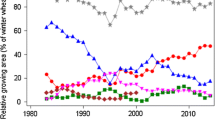Summary
The paper addresses the general question of identifying the optimum environment for selection in plant breeding programs for low input agricultural systems. After defining low-yielding and high-yielding environments based on the average grain yield of large numbers of barley genotypes in different cropping seasons, we examined: 1) the phenotypic relationships between the highest yielding genotypes in low- and high-yielding environments, and 2) the genetic correlation coefficients between grain yield in low- and high-yielding environments. The results indicate that the alleles controlling high grain yield in low-yielding conditions are at least partially different from those controlling high grain yield in high-yielding conditions. Therefore, selection in high-yielding environments is expected to produce a negative response or no response in low-yielding environments. This may explain why crop varieties bred under high-yielding conditions failed to have an impact in low-yielding agricultural systems. The results may be extrapolated to systems where environmental concern suggests a reduction of inputs by raising the question of whether crop breeding programs based on selection under high inputs are likely to generate the right type of germplasm for an environmentally friendly agriculture.
Similar content being viewed by others
References
Allen F.L., R.E. Comstock & D.C. Rasmusson, 1978. Optimal environments for yield testing. Crop Sci. 18: 747–751.
Atlin G.N. & K.J. Frey, 1989. Predicting the relative effectiveness of direct versus indirect selection for oat yield in three types of stress environments. Euphytica 44: 137–142.
Atlin G.N. & K.J. Frey, 1990. Selecting oat lines for yield in low-productivity environments. Crop Sci. 30: 556–561.
Byth D.E., B.E. Caldwell & C.R. Weber, 1969. Specific and non-specific index selection in soybeans, Glycine max L. (Merrill). Crop Sci. 9: 702–705.
Ceccarelli S., 1989. Wide adaptation. How wide? Euphytica 40: 197–205.
Ceccarelli S. & S. Grando, 1989. Efficiency of empirical selection under stress conditions. J. Genet. & Breed. 43: 25–31.
Ceccarelli S. & S. Grando, 1991a. Selection environment and environmental sensitivity in barley. Euphytica 57: 157–167.
Ceccarelli S. & S. Grando, 1991b. Environment of selection and type of germplasm in barley breeding for stress conditions. Euphytica 57: 207–219.
Ceccarelli S., J. Valkoun, W. Erskine, S. Weigand, R. Miller & J.A.G. van Leur, 1992. Plant genetic resources and plant improvement as tools to develop sustainable agriculture. Expl. Agric. 28: 89–98.
Eisen E.J. & A.M. Saxton, 1983. Genotype by environment interactions and genetic correlations involving two environmental factors. Theor. Appl. Genet. 67: 75–86.
Falconer D.S., 1952. The problem of environment and selection. Am. Nat. 86: 293–298.
Falconer D.S., 1981. Introduction to quantitative genetics. 2nd Ed. Longmann Group Ltd., London.
Falconer D.S., 1990. Selection in different environments: effects on environmental sensitivity (reaction norm) and on mean performance. Genet. Res. Camb. 56: 57–60.
Fernando R.L., S.A. Knights & D. Gianola, 1984. On a method of estimating the genetic correlation between characters measured in different experimental units. Theor. Appl. Genet. 67: 175–178.
Frey K.J., 1964. Adaptation of oat strains selected under stress and non-stress environmental conditions. Crop Sci. 4: 55–58.
Gallais, A., 1983. Use of indirect selection in plant breeding. In: Efficiency in Plant Breeding, Proc. 10th Congress of Eucarpia, pp. 45–60. Wageningen, the Netherlands.
Gotoh K. & S. Osanai, 1959. Efficiency of selection for yield under different fertilizer levels in a wheat cross. Jpn. J. Breed. 9: 173–178.
Itoh Y. & Y. Yamada, 1990. Relationships between genotype x environment interaction and genetic correlation of the same trait measured in different environments. Theor. Appl. Genet. 80: 11–16.
Pederson D.G. & A.J. Rathjen, 1981. Choosing trials sites to maximize selection response for grain yield in spring wheat. Aust. J. Agric. Res. 32: 411–424.
Pfeiffer W.H., 1988. Drought tolerance in bread wheat—Analysis of yield improvement over the years in CIMMYT germplasm. In: A.R. Klatt (Ed.) Wheat Production Constraints in Tropical Environments, pp. 274–284. CIMMYT, Mexico DF, Mexico.
Rosielle A.A. & J. Hamblin, 1981. Theoretical aspects of selection for yield in stress and non-stress environments. Crop Sci. 21: 943–946.
Roy N.N. & O.R. Murty, 1970. A selection procedure in wheat for stress environments. Euphytica 19: 509–521.
Simmonds N.W., 1991. Selection for local adaptation in a plant breeding programme. Theor. Appl. Genet. 82: 363–367.
Via S., 1984. The quantitative genetics of polyphagy in an insect herbivore. II. Genetic correlations in larval performance within and among host plants. Evolution 38: 896–905.
Yamada Y., 1962. Genotype by environment interaction and genetic correlation of the same trait under different environments. Jpn. J. Genet. 37: 498–509.
Yamada Y., Y. Itoh & I. Sugimoto, 1988. Parametric relationships between genotype x environment interaction and genetic correlation when two environments are involved. Theor. Appl. Genet. 76: 850–854.
Author information
Authors and Affiliations
Rights and permissions
About this article
Cite this article
Ceccarelli, S., Grando, S. & Hamblin, J. Relationship between barley grain yield measured in low- and high-yielding environments. Euphytica 64, 49–58 (1992). https://doi.org/10.1007/BF00023537
Received:
Accepted:
Issue Date:
DOI: https://doi.org/10.1007/BF00023537




